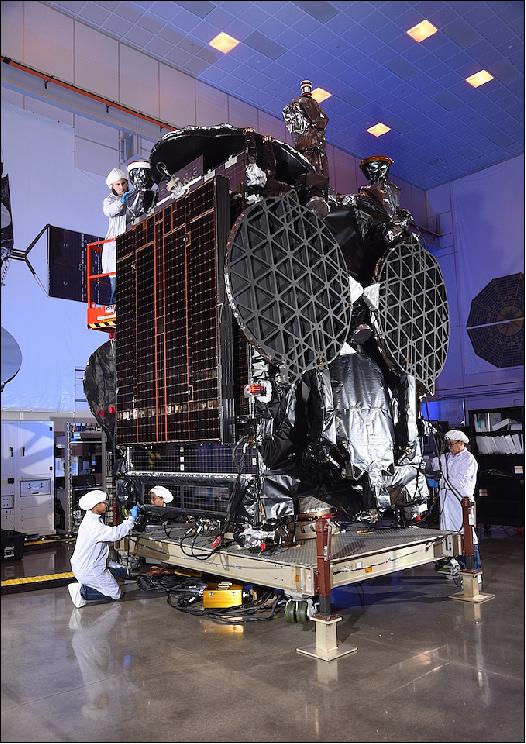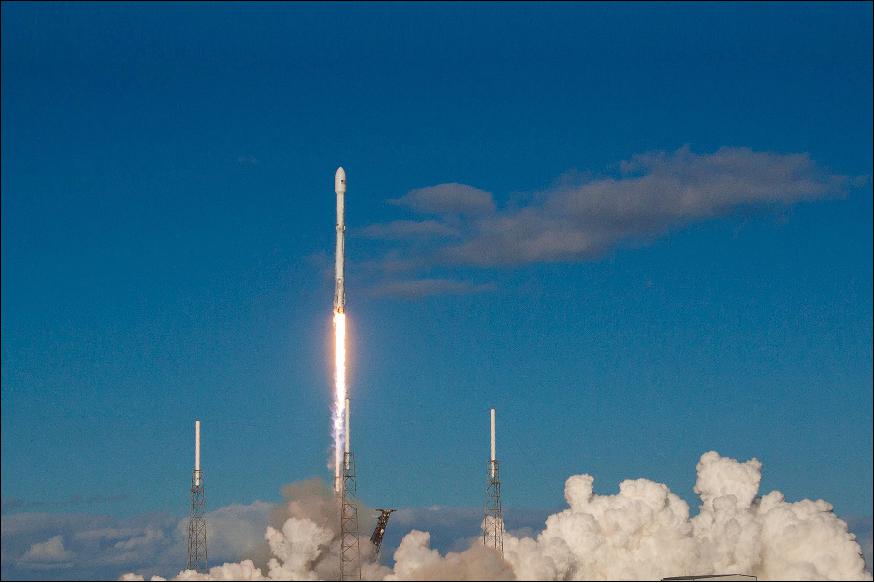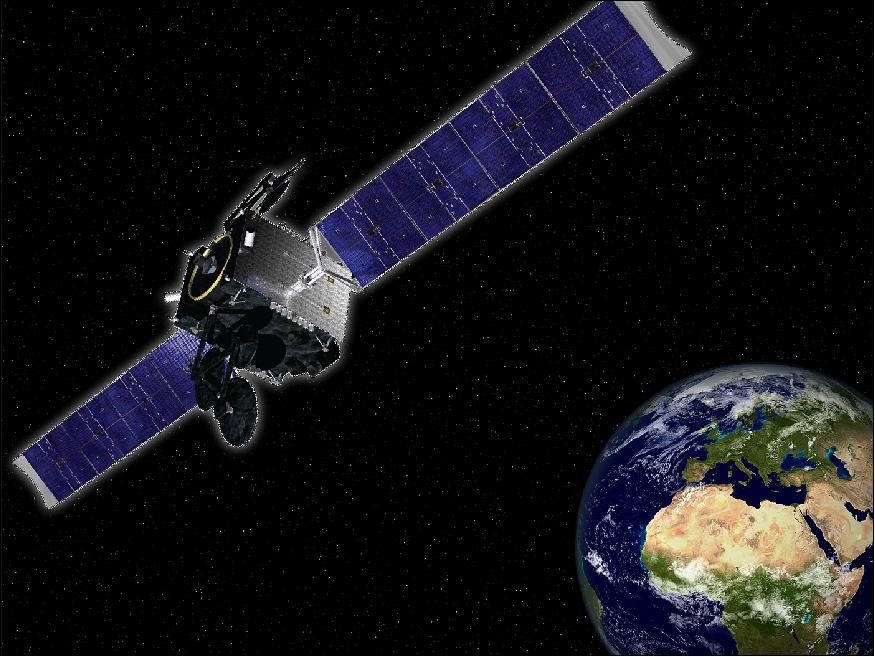GovSat-1 Communication Satellite
EO
Operational (nominal)
Communications
LuxGovSat SA
Quick facts
Overview
| Mission type | EO |
| Agency | LuxGovSat SA |
| Mission status | Operational (nominal) |
| Launch date | 31 Jan 2018 |
| Instrument type | Communications |
| CEOS EO Handbook | See GovSat-1 Communication Satellite summary |
GovSat-1 Communication Satellite
Spacecraft Launch Mission Status Payload References
GovSat is a communication satellite operated by LuxGovSat S.A., a public-private joint venture between the Luxembourg government and SES (Société Européenne des Satellites) S.A., the world-leading satellite operator of Luxembourg. GovSat-1 will be a multi-mission communication satellite that will use X-band and Military Ka-band frequencies on high-power and fully steerable mission beams to support multiple operations. 1)
LuxGovSat ordered the satellite from Orbital ATK in February 2015 as the 40th GEOStar-based satellite sold by the company and the third in the advanced GEOStar-3 platform series.
On 21 November 2017, ESA and an SES-led European consortium agreed to join forces to set up a new platform that will make secure and affordable satcoms available to public users, as part of a Europe-wide push to help governments get the most out of existing systems and services. 2) 3) 4)
Europe's governments often need access to commercial satcom networks at short notice, for example to provide disaster relief or crisis management. They may, however, find themselves unable to use these vital systems and resources owing to national networks being overloaded or damaged. Connectivity and access is not always guaranteed and can come at a high financial cost.
To help solve this problem, satellite operator SES, together with industrial partners Redu Space Services, GovSat, Newtec, QinetiQ and Tekever, have joined ESA's Govsatcom Precursor program to develop a new ‘system of systems' for governments.
Pacis-1 is a central hub in Redu, Belgium, that will pool resources from commercial and governmental satellite systems to ensure that public users have guaranteed and cost-efficient access to secure satcoms when needed.
The Pacis-1 architecture will assign ground and space segment resources according to the user's need. Over the course of the next two years, the consortium will organize dedicated demonstrations to show how the system can improve the safety, responsiveness and efficiency of government missions.
One such demonstration will simulate the use of camera-equipped drones and vehicles to monitor borders. The high-resolution images they gather will be encrypted, transmitted over satellite and disseminated to the field operators in the governmental headquarters, all through Pacis-1.
GovSat's first satellite, GovSat-1, will be launched in early 2018, and operate in X-band and Military Ka-band to provide secure and assured Government services for EU and NATO.
ESA's Govsatcom Precursor projects, including Pacis-1, are the first steps to demonstrate how European space industry can support the future EU Govsatcom initiative.
ESA's Govsatcom Precursor consists of various Pacis projects based on public–private partnerships with all major European satellite operators and service providers. Seven projects, Pacis-1 to -7, are being set up as part of a future federation of demonstration projects in the 2017–20 timeframe. The ESA program will be implemented in synergy with the Govsatcom pooling and sharing demonstration program by the European Defence Agency.
These projects are called Pacis after the Ara Pacis Augustae, an altar in Rome dedicated to the Roman god of peace, Pax.
Spacecraft
GovSat-1, built by Orbital ATK's satellite manufacturing facility in Dulles, Virginia, is based on the company's GEOStar-3 platform. It is an X-band and military Ka-band satellite that provides high-powered and fully steerable spot beams for multiple government missions. The satellite will be positioned on the European geostationary orbit arc and provide coverage to Europe, the Middle East and Africa, along with extensive maritime coverage over the Mediterranean and Baltic seas, and the Atlantic and Indian Oceans. 5)
The GEOStar-3 platform is the newest, highest power and most advanced platform in the flight-proven GEOStar product line. The spacecraft bus features an increase in both battery capacity and solar array power. An additional GEOStar-3 satellite is planned for launch this year.
GovSat-1 is a PPP (Public- Private Partnership) between the Government of Luxembourg and the satellite operator SES. GovSat's mission is to provide secure, reliable and accessible governmental satellite communication services to address the demand resulting from defence and institutional security applications. The company's first satellite GovSat-1 is a multi-mission satellite that will use X-band and Military Ka-band frequencies on high-power and fully steerable mission beams to support multiple operations.
GovSat-1 has a mass of 4,230 kg, power: 8 kW, propulsion: IHI BT-4, 4 x XR-5 Hall Current Thrusters, power is provided by 2 deployable solar arrays and batteries, design life: 15 years (fueled for >16 years).
Designed exclusively for the government and defence community, GovSat-1 is the first satellite of GovSat, which is a joint venture between the Government of Luxembourg and the world-leading satellite operator SES.

Launch
GovSat-1/SES-16 was launched on 31 January 2018 (21:25 UTC) on a Falcon-9 Full Thrust vehicle of SpaceX from the Cape Canaveral Air Force Station SLC-40 (Space Launch Complex-40). 6) 7)
This flight re-used booster B1032 recovered from the NROL-76 mission in May 2017, and landed the first stage in the ocean with the intent to expend it. The booster unexpectedly remained intact, but was not recovered, and it was subsequently destroyed.

Orbit: Geostationary orbit over the equator, altitude of 35786 km, longitude of 21.5ºE.
Coverage: Europe, Middle East, Africa and substantial maritime coverage over the Mediterranean and Baltic Seas, as well as over the Atlantic and Indian Oceans.
The satellite project was financed with 100 million euros ($123 million) invested in a 50-50 shareholder arrangement between SES and the Luxembourg government, plus a 125 million euro ($154 million) loan from a consortium of Luxembourg banks. The startup investments and loan covered LuxGovSat's founding costs, and the procurement of the GovSat 1 spacecraft and its launch on a Falcon 9 rocket. 8)

Mission Status
• March 19, 2018: GovSat-1 enters operational service today, to provide secure communications to governmental and institutional users. GovSat-1 is the first satellite of GovSat, a PPP between the Government of Luxembourg and the world-leading satellite operator SES. The satellite was launched into space on 31 January onboard a flight-proven SpaceX Falcon 9 rocket from Cape Canaveral Air Force Station, and has since undergone extensive testing. 9)
- "GovSat-1 is a real game-changer when it comes to providing secure satellite communications to governments and institutions. The satellite's X-band capacity is the most powerful and flexible available," said Patrick Biewer, Chief Executive Officer of GovSat. "GovSat-1, coupled with our Secure Mission Operations Center, forms one of the most reliable, cost efficient and secure satellite communications capabilities on the market, and we are delighted to announce that it has entered into operational service."
• Feb. 1, 2018: The satellite separated successfully from the launch vehicle approximately 32 minutes into the mission after reaching its targeted orbit. Orbital ATK completed the satellite's initial post-launch health check and configuration in preparation for 16 days of orbit-raising procedures and in-orbit tests. Once testing has been completed, operational control of GovSat-1 will be handed over to GovSat. 10)
Spacecraft
The satellite is entirely dedicated to government and institutional users, and will be operated by GovSat from the Secure Mission Operations Center in Luxembourg. GovSat-1 has a diverse mix of transponder sizes in terms of bandwidth per transponder, offering in total 68 transponder-equivalent units of 36 MHz.
GovSat-1 was designed for dual use to support both defence and civil security applications, including mobile and fixed communications. It is a multi-mission satellite that offers X-band and Military Ka-band capacity. The spacecraft will provide up to six high-powered and fully steerable spot beams, as well as an advanced Global X-band beam. 11)
The X-band frequency is reserved for governments and institutions, and is an ideal mean to establish secure and robust satellite communication links, for example between theaters of tactical operations, maritime missions or over areas affected by a humanitarian crisis. The X-band payload delivers a global beam covering a wide area from 50°W to 90°E and 70°N and 70°S supporting various secure communications links with a capability compliant with NATO's stated Level of Ambition of a Major Joint Operation. Multiple-Mission Beams that are fully steerable can direct focused coverage on key mission areas, supporting critical and secure communications for localized theaters.
The military Ka-band will be used predominantly for mobility applications in support of ISR (Intelligence Surveillance and Reconnaissance) missions. The secure communication links it enables are characterized by smaller high-throughput VSAT terminals. The Mediterranean sea is one particular area covered by a high-power beam in military Ka-band. It is therefore ideally suited to enable communications for European Border Surveillance applications.
The Ka-band comprises an Anchor Beam and, like the X-band, also delivers multiple-mission beams with high-power characteristics. The Anchor Beam spans the entire European Continent and will mainly be used for interconnecting headquarters, government institutions or defence sites within Europe while the multi-mission beams enable high-bandwidth and data-intensive applications over small antennas. The Ka-band multi-mission architecture is primarily geared toward ISR and COTM (Communications on the Move).
Equipped with anti-jamming features, encrypted telemetry and control, and frequencies reserved for governmental use, GovSat-1 will also provide enhanced resilience capabilities for more reliable connectivity.
References
1) https://www.govsat.lu/about
2) "‘System of systems' for secure government satcoms," ESA, 21 Nov. 2017, URL: http://m.esa.int/Our_Activities/Telecommunications_Integrated
_Applications/System_of_systems_for_secure_government_satcoms
3) https://web.archive.org/web/20161231044129/https://www.govsat.lu/what-we-offer
4) "GovSat-1's mission," URL: https://www.ses.com/our-coverage/satellites/371
5) "Mission Update: GovSat-1," Orbital ATK, 31 Jan. 2018, URL: [web source no longer available]
6) "GovSat-1 Mission," SpaceX, 31 Jan. 2018, URL: http://www.spacex.com/news/2018/02/06/govsat-1-mission
7) "GovSat-1 Successfully Launched on SpaceX Falcon 9 Rocket," SES, 31 Jan. 2018, URL: https://www.ses.com/press-release/govsat-1-successfully
-launched-spacex-falcon-9-rocket
8) Stephen Clark, "Luxembourg-backed telecom craft set for launch on reused Falcon 9 rocket," Spaceflight Now, 29 Jan. 2018, URL: https://spaceflightnow.com/2018/01/29/luxembourg-backed-communications
-craft-set-for-launch-on-reused-falcon-9-rocket/
9) "GovSat-1 Satellite Goes Operational," GovSat, 19 March 2018, URL: https://www.govsat.lu/news/govsat-1-satellite-goes-operational
10) "Orbital ATK-Built GovSat-1 Multi-Mission Satellite Successfully Launched," Orbital ATK Press Release, 1 Feb. 2018, URL: [web source no longer available]
11) "GovSat-1: Secure Communications for Governments," SES, 19 Jan. 2018, URL: https://www.ses.com/newsroom/govsat-1-secure-communications
governments#gQFC1Z1077O10vi0.99
The information compiled and edited in this article was provided by Herbert J. Kramer from his documentation of: "Observation of the Earth and Its Environment: Survey of Missions and Sensors" (Springer Verlag) as well as many other sources after the publication of the 4th edition in 2002. - Comments and corrections to this article are always welcome for further updates (eoportal@symbios.space).
Spacecraft Launch Mission Status Payload References Back to top